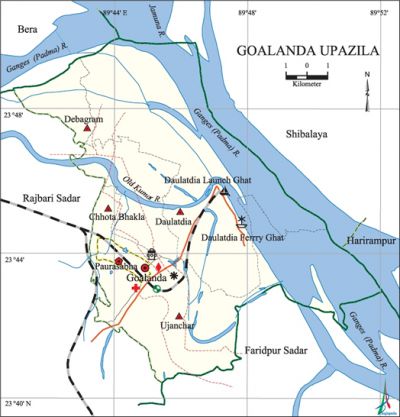Goalanda Upazila
Goalanda Upazila (rajbari district) area 121.82 sq km, located in between 23°41' and 23°50' north latitudes and in between 89°41' and 89°51' east longitudes. It is bounded by bera and shiValaya upazilas on the north, faridpur sadar and rajbari sadar upazilas on the south, Shibalaya and harirampur upazilas on the east, Rajbari Sadar upazila on the west.
Population Total 112732; male 54913, female 57819; Muslim 108154, Hindu 4576, Buddhist 1 and others 1.
Water bodies Main rivers: padma, Old Kumar.
Administration Goalanda Thana was formed in 1920 and it was turned into an upazila in 1984.
| Upazila | ||||||||
| Municipality | Union | Mouza | Village | Population | Density (per sq km) | Literacy rate (%) | ||
| Urban | Rural | Urban | Rural | |||||
| 1 | 4 | 111 | 152 | 30190 | 82542 | 925 | 47.3 (2001) | 35.7 |
| Municipality | ||||||||
|
Area (sq km) |
Ward |
Mahalla |
Population |
Density (per sq km) |
Literacy rate (%) | |||
| 4.86 (2001) | 9 | 15 | 18663 | 4351 (2001) | 58.5 | |||
| Upazila Town | ||||||||
|
Area (sq km) |
Mouza |
Population |
Density (per sq km) |
Literacy rate (%) | ||||
| 16.26 (2001) | 5 | 11527 | 675 (2001) | 42.9 | ||||
| Union | ||||
| Name of union and GO code | Area (acre) | Population | Literacy rate (%) | |
| Male | Female | |||
| Ujanchar 76 | 7206 | 13575 | 14141 | 40.2 |
| Chhota Bhakla 19 | 3076 | 7685 | 8506 | 47.2 |
| Debagram 57 | 5854 | 7884 | 8140 | 30.7 |
| Daulatdia 38 | 12768 | 16562 | 17576 | 31.1 |
Source Bangladesh Population Census 2001, Bangladesh Bureau of Statistics.

War of Liberation During the war of liberation in 1971 a number of villagers were killed in air raid by the Pak army. On 21 April an encounter was held between the freedom fighters and the Pak army in which two freedom fighters were killed. In another encounter with the Pak army on 22 April four freedom fighters were killed in this upazila.
For details: see গোয়ালন্দ উপজেলা, বাংলাদেশ মুক্তিযুদ্ধ জ্ঞানকোষ (Encyclopedia of Bangladesh War of Liberation), বাংলাদেশ এশিয়াটিক সোসাইটি, ঢাকা ২০২০, খণ্ড ৩।
Literacy rate and educational institutions Average literacy 40.3%; male 42.6%, female 38.2%. Educational institutions: college 2, secondary school 5, primary school 37, madrasa 17.
Cultural organisations Library 2, club 18, shilpakala academy 1, cinema hall 2, press club 1, theatre group 2, women organisation 2.
Important installations Goalanda Ferry Ghat and Goalanda Launch Ghat.
Main sources of income Agriculture 48%, non-agricultural labourer 4.45%, industry 0.77%, commerce 18.98%, transport and communication 6.28%, service 7.48%, construction 3.72%, religious service 0.17%, rent and remittance 0.51% and others 9.64%.
Main crops Paddy, jute, sugarcane, pulse, peanut.
Extinct or nearly extinct crops Rai, variety of mustard oil seed.
Main fruits Mango, jackfruit, guava, papaya.
Fisheries, dairies and poultries Fishery 98, dairy 35, poultry 67, hatchery 1.
Communication facilities Pucca road 48.86 km, semi-pucca road 10.48 km, mud road 90.87 km; railway 10 km; waterway 4 km.
Extinct or nearly extinct traditional transport Palanquin, bullock cart and horse carriage.
Noted manufactories Sunipun Organics, Goalanda Textile Mills.
Cottage industries Blacksmith, Potteries, bamboo and wood work, nakshi kantha, nakshi pakha.
Hats, bazars and fairs Hats and bazars are 6, fairs 2, most noted of which are Goalanda Hat and Goalanda Mela.
Main exports Jute, sugarcane molasses.
Access to electricity All the wards and unions of the upazila are under rural electrification net-work. However 45.0% of the dwelling households have access to electricity.
Sources of drinking water Tube-well 97.4%, tap 0.3% and others 2.3%.
Sanitation 62.0% of dwelling households of the upazila use sanitary latrines and 35.0% of dwelling households use non-sanitary latrines; 3.0% of households do not have latrine facilities.
Health centres Upazila health complex 1, union health centre 3, health and family welfare centre 3, clinic 3.
Natural disasters The tornado of 1961 caused heavy damages to settlements and properties of the upazila.'
NGO activities Operationally important NGOs are brac, asa, Samaj Kalyan Sangstha, Grameen Samaj Unnayan Sangstha. [Md Abu Hasan Farooque]
References Bangladesh Population Census 2001 and 2011, Bangladesh Bureau of Statistics; Cultural survey report of Goalanda Upazila 2007.
